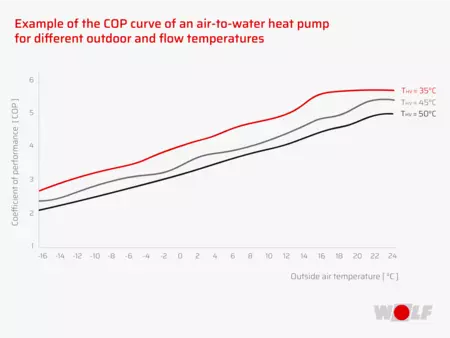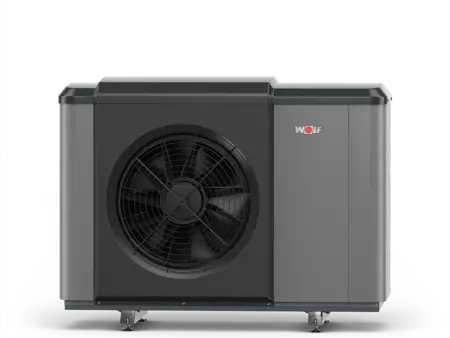
How to calculate the efficiency of a heat pump
Heat pumps are the most popular heating system used in new buildings. And no wonder: They are both environmentally friendly and use freely available environmental heat. However, they require a small amount of electricity to operate. For this reason, it is important to know the efficiency of heat pumps so that you can evaluate their performance individually.
How do heat pumps work?
Heat pumps use coolant to extract heat from the surrounding air, ground or groundwater and boost the temperature in a cyclical process. The converted thermal energy is transferred to the building’s heating system during this process.
Synthetic and natural coolants are available on the market. WOLF R290 (propane) is an example of a natural coolant. It is environmentally friendly, not harmful to the ozone layer and has barely any impact on the greenhouse effect. Moreover, this natural coolant improves the efficiency of the system.
What is the efficiency level of a heat pump?
The efficiency level of a heat pump describes how efficiently the heat pump works. It indicates how many units of heat it can produce from one unit of electricity.
Expressed in formulas:
- Efficiency = heating energy / electricity
- Efficiency = effective output / power input
What affects the efficiency level of heat pumps?
The job of a heat pump is to bridge the difference in temperature between the heat source and the flow temperature of the heating system. This temperature differential depends not only on the flow temperature but also on the type of heat pump.
Air-to-water heat pumps, such as the WOLF CHA-Monoblock, use heat from the ambient air. The outside air may be below 0°C in winter so, at flow temperatures of between 30°C and 35°C, the heat pump has to bridge a considerable temperature differential. Brine-to-water heat pumps use geothermal heat and water-to-water heat pumps use heat from groundwater.
As the temperature of groundwater rarely drops below 12°C, the temperature difference to the flow temperature is lower and the system consumes less electrical power. This increases the efficiency level of the heat pump.
Example calculation: Is it worth installing a heat pump?
The following example calculation shows the minimum efficiency required for a heat pump to be more economical than, for instance, an old oil heating system.
We will assume that electricity costs 20 cents/kWh and heating oil 5.8 cents/kWh. In this case, the heat pump would need an efficiency level of 3.4 (20 / 5.8) to cost the same amount to run.
So installing the heat pump would be economical as long as it has an efficiency level above 3.4.
COP or SPF?
The coefficient of performance (COP)
The COP is determined by taking measurements under standardised conditions (DIN EN 255, DIN EN 14511). It is a constant property of the heat pump and specifies a ratio for every pair of values consisting of the heat source temperature and flow temperature. The graphic shows that both a lower flow temperature and also a higher air temperature raise the COP.

The seasonal performance factor (SPF)
In contrast, the SPF is the average efficiency of the heat pump measured over one year of operation. Electricity consumption and the generated heat are continuously measured to calculate this value.
How can I determine the SPF?
You do not need to measure the SPF yourself. The COP of a heat pump can be calculated using standardised procedure VDI 4650 and the manufacturer’s data.
You can calculate the SPF very easily using our SPF calculator for heat pumps. To do so, enter the heat source and model of the heat pump, such as the CHA-07, and a few other details. Click on “Update” to start the SPF calculation for the heat pump in question.
The example given here returns an SPF of 4.6. This air-to-water heat pump (e.g. the WOLF CHA-Monoblock) would therefore be eligible for subsidy from the BAFA if used either in older buildings or new buildings. Once finished, you can conveniently download your SPF calculator results and use them to support your BAFA subsidy application.
The SPF is a key figure that expresses the efficiency of a heat pump in a specific heating system. It is essential to know this value when applying for subsidies from the German Federal Office for Economic Affairs and Export Control (BAFA), for example.
Air-to-water heat pump
CHA-MONOBLOCK
The WOLF CHA Monoblock heat pump is sure to fit in with the overall design of your home, and is perfect in the garden, out on the patio or mounted on the wall – all with an impressive COP of 4.65.

How to optimise the efficiency of a heat pump
The COP and seasonal performance factor are not only useful when selecting a heat pump. They can also signal the need for optimisation during ongoing operation.
There are several ways to increase the efficiency of a heat pump:
- Use a more efficient compressor – this measure is especially useful for older heat pumps.
- Optimise the heating system – this does not change the efficiency of the heat pump but does reduce your heating requirements.
- Enlarge the area of the heating surfaces by using underfloor or radiant panel heating systems – this enables you to use a lower flow temperature. Reducing the flow temperature by 5°C potentially raises the SPF by up to 10%.
Heating technicians can also check the efficiency of the system and make any necessary adjustments during regular heat pump maintenance. Simply optimising the settings is often enough to achieve considerably better results. This protects the environment and lowers the cost of heating and electricity.


